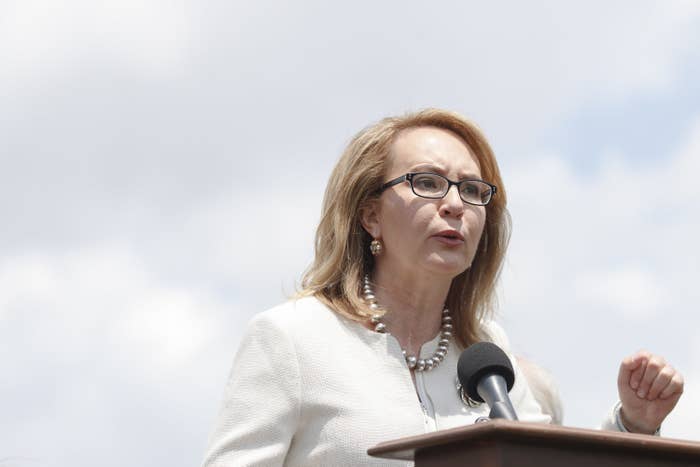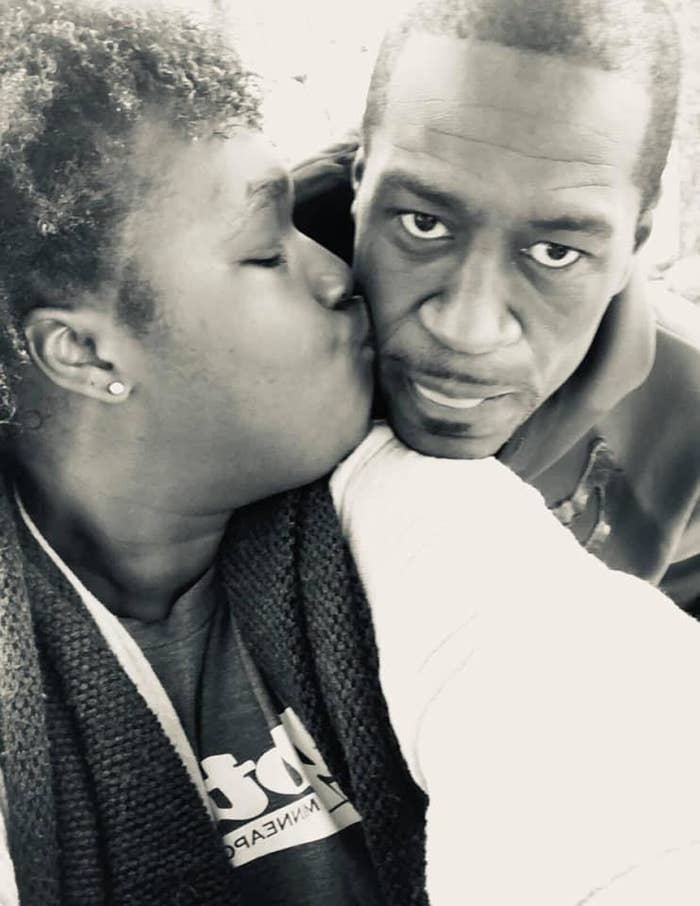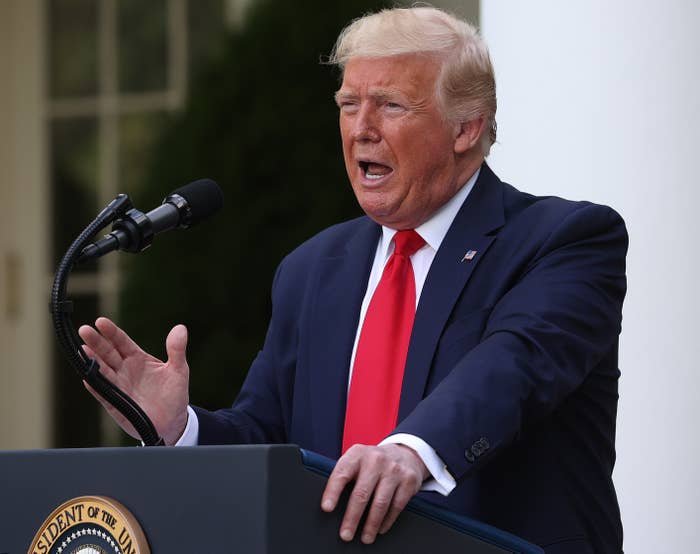Gabby Giffords' Group Condemned Trump For Sharing A Video Saying "The Only Good Democrat Is A Dead Democrat"
Giffords was almost killed by a gunman in 2011 when she was a Democrat representing Arizona in Congress.
Julia ReinsteinBuzzFeed News Reporter
Last updated on May 28, 2020Tweet
President Donald Trump retweeted a video on Thursday in which a supporter said that "the only good Democrat is a dead Democrat," earning the condemnation of prominent Democrats — including the anti–gun violence group founded by Gabby Giffords, the former Democratic member of Congress who was almost assassinated by a gunman in 2011.
Peter Ambler, cofounder of Giffords' organization, told BuzzFeed News the US had already "seen the deadly consequences of the twin threats of hateful rhetoric and loose gun laws."
"My hometown of El Paso suffered a horrific tragedy because a man motivated by hate drove 10 hours to slaughter Latinos with a gun," Ambler said. "We've already seen armed men enter state capitals in attempts to intimidate lawmakers navigating pandemic response."
"Trump’s encouragement of violence, harassment, and intolerance is a threat to our core democratic institutions, and it's going to result in further violence and tragedy," he said. "It must end now.”

Tom Brenner / Getty Images
In the video shared by the president, which was posted Wednesday by the account "Cowboys for Trump," Couy Griffin, an Otero County, New Mexico, commissioner, can be heard speaking at a rally against the state's restrictions to slow the spread of the coronavirus.
The May 17 protest in the city of Truth or Consequences was held after a local church received a cease-and-desist order for illegally holding in-person services, according to NM Political Report.
“I’ve come to a place where I’ve come to the conclusion that the only good Democrat is a dead Democrat," Griffin says in the recorded speech, to cheers and applause.

Donald J. Trump@realDonaldTrump
Thank you Cowboys. See you in New Mexico! https://t.co/aCRJeskUA804:00 AM - 28 May 2020
Reply Retweet Favorite
After the cheers die down, Griffin then adds that he does not mean that "in the physical sense."
"I don’t say that in the physical sense, and I can already see the videos getting edited where it says I wanna go murder Democrats," Griffin says. "No, I say that in the political sense, because the Democratic agenda and policy is anti-American right now."
Trump retweeted the Cowboys for Trump video at midnight on Thursday, saying, "Thank you Cowboys. See you in New Mexico!"
In response to questions about the tweet, a White House spokesman told BuzzFeed News the president condemns violence.
"The President and the entire administration condemn violence in all forms as we have stated many times," White House spokesman Judd Deere said in an email.
Griffin was photographed meeting Trump in the Oval Office in February, reportedly after he and a group of supporters rode horseback from Cumberland, Maryland, to Washington, DC, in support of Trump's declaration of a national emergency to build a wall along the US–Mexico border.
Trump's sharing of the video was also criticized by Beto O'Rourke, the former Texas representative who made an unsuccessful presidential run last year on a gun control platform.

Beto O'Rourke@BetoORourke
ter·ror·ism /ˈterəˌrizəm/ noun: terrorism the unlawful use of violence and intimidation, especially against civilians, in the pursuit of political aims.04:36 PM - 28 May 2020
Reply Retweet Favorite
New Mexico political leaders have called for Griffin to resign over his remarks, which Lt. Gov. Howie Morales called "incredibly irresponsible."
“Violent speech like this has no place in New Mexico politics,” said Democratic Party of New Mexico chair Marg Elliston.
Member of Griffin's own party denounced his statements, with the New Mexico Young Republicans calling for him to apologize and saying "such an outrageous statement is contrary to the pro-life Republican Party platform."
The New Mexico GOP tweeted that "any statements, whether in jest or serious about harming another individual are just plain wrong."

New Mexico GOP@NewMexicoGOP
The Republican Party of New Mexico wants to state for the record that any statements, whether in jest or serious about harming another individual are just plain wrong.07:11 PM - 20 May 2020
Reply Retweet Favorit
In an interview with ABC-7, Griffin said he would not resign.
"If their demand was warranted, then I would consider it," Griffin said. "But their demand for me to step down because of that instance in which I said 'the only good Democrat is a dead democrat' when I was talking about politics to begin with — I believe it's unwarranted."
In an interview with the Daily Beast, Griffin admitted he should have chosen his words better.
“I could’ve chosen a different verbiage, you know. I guess I need to be more careful when I choose the words that I speak,” Griffin said. “But you know, it’s just so hypocritical of the left how they’re blowing this up, like I’m some hate-speech murderer.”
But Griffin also said he would not rule out violence as a tactic for the reopening protests.

Jeenah Moon / Getty Images
Couy Griffi
“I’ll tell you what, partner, as far as I’m concerned, there’s not an option that’s not on the table,” Griffin said.
He also repeated to the Daily Beast that "the only good Democrat is a dead Democratic," and said he thinks some Democrats, including Virginia Gov. Ralph Northam and Michigan Gov. Gretchen Whitmer, could be guilty of treason and even suggested they be punished by execution for it.
“You get to pick your poison: You either go before a firing squad, or you get the end of the rope,” Griffin said.
Griffin has a history of calling for violence and the execution of Democrats.
According to KRWG, he has repeatedly said Democrats should be hanged for "treason" and has said laws requiring masks could result in "civil war."
Griffin did not immediately respond to a request for comment from BuzzFeed News.

Julia Reinstein is a reporter for BuzzFeed News and is based in New Yor











